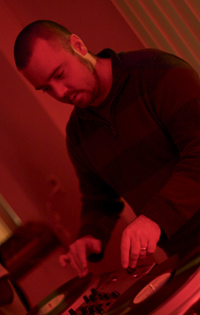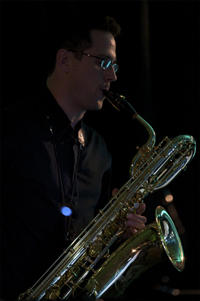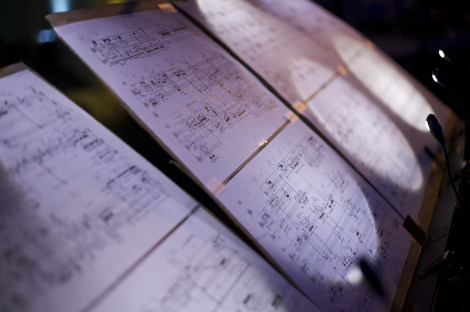Matthias Röder speaks with the founders of mobtown modern, saxophonist Brian Sacawa and composer Erik Spangler, about recliners and drinks at New Music concerts, how alternative listening environments and video projections create remixes of well-known repertories, and what’s coming up next in Baltimore’s most innovative New Music series.
Zeitschichten.com: Erik, together with Brian Sacawa, you are curating mobtown modern, a new music series at the contemporary museum in Baltimore. What’s the concept behind mobtown modern and why are you teaming up with a museum?
Listen to
Hybrid Groove Project: Pastlife Laptops
Erik Spangler: The main purpose of mobtown modern is to introduce a wider audience to a range of new music that we personally find inspiring, and to shape a total experience for the listener that is more welcoming than the academic concert hall. We are working in partnership with the Contemporary Museum because we have a shared understanding of new music as a vital form of contemporary art, and they are generously donating a space to us in which we can design our ideal listening environment.
Zeitschichten.com: What constitutes such an ideal listening environment?
Erik Spangler: When I say “ideal”, I should clarify that it is not acoustically ideal for everything that we are doing, but that we are able to consciously shape the environment to our purposes. It is a blank space that we are able to redesign ourselves, thinking consciously about setting the general atmosphere. We typically create a lounge type of environment, with some very comfy recliners in the first few rows of our semi-circular seating arrangement, and some cocktail tables set up behind the rows of chairs. We set up a bar at the back, next to my DJ table, where people can grab a drink at any point during the event. How many times have you wished for that during a classical music concert? Behind the performers we have two large screens where our video artist, Guy Werner, projects his visual interpretations of the music. Guy also does unique lighting design for each of our shows. There are many different ways that you can experience this space as a listener, and I think it welcoming to a wider variety of people than the traditional concert hall.
Zeitschichten.com: The mobtown modern concert programs are always structured around a central theme. Last year’s October concert, for instance, was entitled “Sound Ecology” and featured music that was inspired by environmental sounds. The series’ first concert was dedicated to non-academic compositions (“To Cool For School”) while “Man vs. Music” showcased pieces that are extremely difficult to play. What is your aim in presenting themed concerts? Do you think that New Music needs mediation in order to be understood or enjoyed by the public?
Erik Spangler: We have organized each of our events around a central theme because we like to program the music very intentionally, like a “concept album,” in a way that creates links between the pieces. The flow from one piece to another, the dramatic arc of the event, is also really important. I personally think that anything we can do as presenters of challenging new music to draw an audience in, to create meaningful connections, should be looked into. New music doesn’t necessarily need mediation, but we see it as another opportunity for creativity.
Zeitschichten.com: When you say “creativity,” do you imply that the act of listening requires a creative mindset and that this mode of listening is fostered by a non-traditional performance venue?

Erik Spangler
Erik Spangler: We do see the non-traditional performance venue as a way of fostering a listening mindset that encourages you to hear the music through the lens of today’s culture, rather than through assumed concert-going traditions of the past. This specially designed listening environment automatically creates a “remix” of the music by presenting it in a different social context than the one in which it was probably envisioned by the composer. We also remix the musical compositions by presenting them in relation to new visuals. Sometimes the music is more directly remixed with the addition of new electronic layers, new instrumental arrangements, and DJ interludes between pieces.
Zeitschichten.com: Erik, as a composer you connect classical contemporary and hip hop styles, working mostly with electronic media. What are your main influences when it comes to electronic music?
Erik Spangler: I continue to work with both acoustic instruments and electronic media in my composition work, although electronica has become more central for me since it enables me to regularly perform my own music as a DJ. During my last several years as a composition graduate student I was inspired to start sampling from my acoustic compositions and to incorporate these sounds into instrumental Hip Hop, Dub, and Drum & Bass beats. My biggest influences in this area of composition have been DJ Krush, DJ Spooky, Blockhead, Prefuse 73, and Amon Tobin.
Zeitschichten.com: Many of your past concerts featured a prominent visual component, for instance in the form of special lighting or video projections. Brian, as executive director of the concert series you are – among other things – in charge of hiring musicians. Are musicians generally happy about the visual component of the concerts or do you need to convince them that the visuals do not distract the listeners but rather enhance their understanding and perception of the music?

Brian Sacawa
Brian Sacawa: We’re lucky to have the opportunity to be working with very open minded musicians who share our desire to enhance the listening experience through multimedia means. So far, none of our musicians have objected to the use of video during our shows.
There has been one instance when a composer objected to the addition of a video layer to his work and we were happy to accommodate him. I can understand this perspective and realize that some composers may want their works to stand alone and not be enhanced or “polluted” by a video presentation. I’ve definitely been to concerts that combined music and video poorly; I’m thinking of particular instances when the music, which should be the main focus of the evening, becomes subservient and almost like a soundtrack for the video being presented. That’s definitely not what we’re after. We try to overcome this issue by having our video mixed live during the performance so it’s more reactionary to the music, making the VJ an active participant in the performance as he improvises a video layer to the music. We’re fortunate to have Baltimore-based video artist Guy Werner working as our primary VJ. Prior to each concert, Guy listens to the pieces and gets a general idea of the theme and images he’ll use as source material. He then prepares banks of samples for each piece—just like a DJ bringing a big record bag to a turntable gig—and then improvises a new video layer live during the performance. Using this method for the video, we could perform any piece several times and never have the same exact visual material.
Zeitschichten.com: You have frequently participated in the mobtown modern concert series as a performer. Do the video projections have an impact on your interpretation of a work? Is there a dialog between musical performance and video projections?
Brian Sacawa: Since the projections are always done behind the performers, I can’t say that they have any influence on my interpretation of any given work. However, there is definitely a dialog between the video projections and the musical performance, but that comes exclusively from the video end. As I mentioned, our video artist Guy Werner, prepares banks of samples based on the feeling he gets from listening to a recording of the work prior to the concert. So he has a general “theme” of what his video will be though everything he does during the performance in terms of mixing and effects is purely improvisatory and influenced by the dynamic of the live performance.
Zeitschichten.com: In terms of the equipment needed for the series, what is the biggest challenge of not staging the concerts in a traditional hall?
Brian Sacawa: I think we’d have the same types of challenges in terms of equipment even if we had our concerts in a traditional hall. Not many concert venues have the sort of video and audio capabilities that we require for our series. If anything, having the shows where we do, in a kind of loft-like space, makes things easier for us; we’re not locked having thing in a certain space and so on. It’s more flexible and gives the option of changing things around if we feel like it.
In terms of the equipment that we do use for the concerts, again, we have some very dedicated people who contribute their own gear along with their services for extremely reasonable fees.
Zeitschichten.com: As a performer you have premiered many pieces for saxophone and live electronics. What are the skills that one needs to have when performing electro-acoustic music? Is it different from playing with other musicians?
Brian Sacawa: There’s definitely a different type of skill set involved when performing electroacoustic music as opposed to performing with other musicians. First, you really need to know every detail of the electronic part. Often, the only way you know if you are synced up properly is through subtle cues in the electronic part. In some pieces, like Erik’s “pastlife laptops and attic instruments,” this isn’t a huge concern since there is a prominent beat-based layer, while in others, say “Images” by Milton Babbitt, being attuned to shifts in timbre and register can really make or break a performance.
Second, unlike playing with other musicians, an electronic track is completely unforgiving. If you make a mistake the CD playback doesn’t adjust to you. Also, your sense of time has to be ultra-precise. For example, I have performed several compositions by Jacob ter Veldhuis and these pieces are quite rhythmic and sometimes have the live saxophone as much a part of the texture as the electronic part. Being able to blend in both timbrally as well as in perfect tempo is extremely important to the success of a performance of one of these works.
And finally, the most dangerous aspect of performing electroacoustic music is the technology aspect of it. Computers don’t like to work when you want them to. And you have to have good audio equipment to have a great sound during performances. So there’s an added aspect that is often out of your control as a performer, especially when you travel and play in different venues all the time.
Zeitschichten.com: Can you tell us something about upcoming concerts in the mobtown modern series?
Brian Sacawa: We have two concert left this season. Our next concert is the Sequenzathon, a marathon performance of Berio’s Sequenzas. We’ll end this season with a show we’re called “Out To Lunch”, which will feature music be composers who have at one time or another in their careers been called “crazy.” On this concert we’re programming music by Edgard Varese, Eric Dolphy, Frank Zappa, Karlheinz Stockhausen, and Alvin Lucier. We’re also very, very excited about what we’ve got programmed for Season 3, though that’s a secret for now!
Zeitschichten.com: Thanks to both of you for this interview!





[…] With impeccable timing in advance of Mobtown Modern’s show next week, there’s a new interview with Erik and I up at the web magazine Zeitschichten. Many thanks to Matthias Röder for the […]
Hi,
entirely enjoyed this..you made my evening !
[…] anthology of free downloads from DJ Dubble 8 aka Erik Spangler, who is one of the two curators of Mobtown Modern. It is hosted on alonetone.com, a new music service that lets you host and share your music across […]